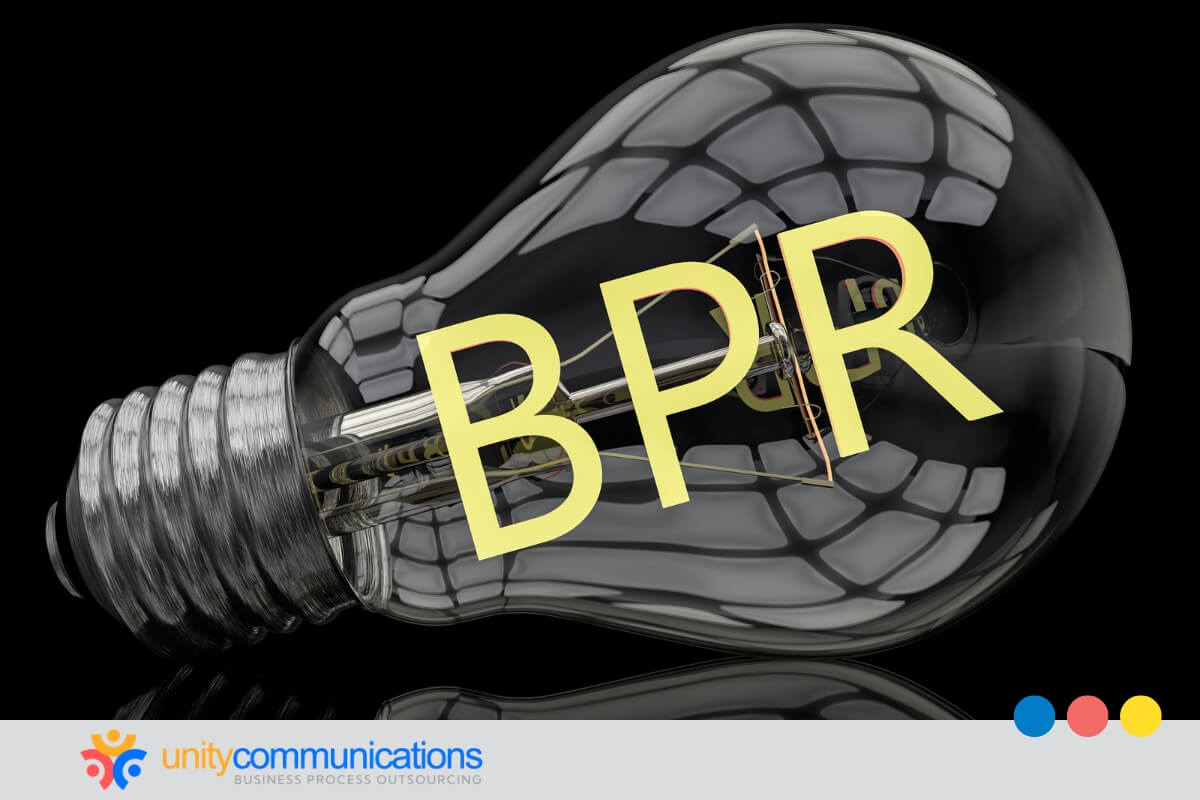Table of Contents
Efficiency and innovation have become critical to navigating complex global operations and evolving customer demands in the fast-paced business process outsourcing (BPO) landscape.
In this realm, business process reengineering (BPR) has emerged as a driving force in reshaping operational frameworks and leading service providers toward heightened productivity and groundbreaking innovation.
This article delves into how BPO operations are further transformed by process reengineering, streamlining operations, optimizing resources, and fostering a culture of continuous improvement.
Fundamentals of BPO process reengineering

BPR involves the systematic redesign of processes, workflows, and structures within outsourced operations to significantly improve efficiency, effectiveness, and innovation. It is so widespread that its market value reached $9.64 billion in 2021 and can hit $21.47 billion by 2029.
In BPO, client companies delegate specific tasks or key processes to external service providers. Process reengineering optimizes this entire outsourcing ecosystem. It encompasses the processes carried out by the outsourcing provider and the interactions and handoffs between the client company and the BPO partner.
BPR in BPO settings typically involves the following key steps:
- Process analysis. Understand and document the existing processes involved in the outsourced operations. The analysis identifies inefficiencies, bottlenecks, redundancies, and areas for improvement.
- Process reimagining. Challenge the status quo and reimagine how to perform tasks and activities to achieve better outcomes. This step often entails brainstorming sessions, workshops, and stakeholder collaboration to generate innovative ideas.
- Workflow redesign. Based on the insights from the analysis phase, develop new process designs and workflows. The redesigned processes must streamline operations, eliminate unnecessary steps, and leverage technology to automate routine tasks.
- Technology implementation. Introducing advanced technologies such as artificial intelligence (AI), robotic process automation (RPA), and data analytics can enhance process efficiency and effectiveness. These technologies can automate repetitive tasks, provide real-time insights, and enable predictive decision-making.
- Training and change management. BPO training equips team members with the necessary skills and knowledge to adapt to the reengineering effort. Implement change management strategies to ensure smooth transitions and foster a culture of continuous improvement.
- Monitoring and optimization. Continuously monitor the performance of the re-engineered processes and make adjustments as needed to enhance efficiency, quality, and innovation. Gather feedback from stakeholders, analyze key performance indicators (KPIs), and iterate on the process designs.
A question generally raised when discussing BPR is if it is similar to business process improvement (BPI). Although both aim to enhance organizational processes, they differ in scope, approach, and objectives.
BPR involves radical transformation and innovation to achieve breakthrough results, challenging traditional ways of thinking and operating. It seeks significant improvements in performance, efficiency, and effectiveness.
BPI follows an iterative approach, focusing on incremental changes to existing processes to achieve specific goals over time. It emphasizes continuous learning and adaptation to gradually optimize processes.
Improving BPO efficiency and innovation with process reengineering
BPO process reengineering is a strategic approach aimed at fundamentally redesigning business processes to achieve dramatic improvements in efficiency, effectiveness, customer satisfaction, and innovation.
Around 79% of customers expect consistent interactions across various departments, but approximately 55% feel they are dealing with separate departments rather than a unified company.
Seamless and interconnected processes correlate with increased customer satisfaction. BPR emphasizes the mapping of customer journeys to enhance optimization.
When applied to BPO operations, process improvement methodologies can profoundly influence efficiency and innovation.
Here’s how:
- Streamlined processes. BPR reimagines existing processes to eliminate redundant steps, reduce delays, and optimize workflows. By streamlining processes, BPO operations can deliver services to clients more efficiently. They can quickly complete tasks with fewer errors, improving turnaround times and productivity.
- Leveraged technology. BPR typically adopts advanced technologies to automate repetitive tasks, enhance decision-making capabilities, and provide valuable insights for process optimization. Leveraging technology effectively drives efficiency gains and delivers innovative solutions to clients.
- Increased focus on value-adding activities. BPO operations can identify and prioritize value-adding activities that directly contribute to client satisfaction and business success. Reallocating resources away from non-essential tasks and toward core activities enhances service quality and market differentiation.
- Agile and adaptable operations. BPR encourages BPO operations to be nimble in responding to changing market dynamics, client requirements, and technological advancements. By redesigning processes, BPO providers can quickly adapt to new challenges and opportunities, driving continuous improvement and innovation.
- Collaborative partnerships. BPR fosters collaborative partnerships between BPO providers and their clients, enabling co-innovation and knowledge sharing. By working closely with clients to understand business objectives and challenges, BPO providers can tailor solutions that address specific needs and drive mutual value creation.
- Continuous improvement culture. BPR instills a culture of continuous improvement that encourages employees to identify inefficiencies, propose innovative ideas, and participate in process optimization efforts. Empowering employees to take ownership of their work fosters sustainable efficiency gains and a culture of innovation.
Strategies for implementing process reengineering in BPO

BPR comprises seven significant stages:
- Shifting organizational values toward customer requirements and eliminating tasks of low significance
- Simplifying and standardizing intricate tasks while automating repetitive ones
- Empowering processes through contemporary systems and data integration
- Identifying the most efficient and effective environment for performing tasks
- Restructuring businesses into cross-functional teams with comprehensive responsibility for processes
- Reevaluating fundamental organizational and personnel aspects
- Identifying suitable roles for third-party companies, emphasizing their value addition
What is the role of BPO firms in implementing BPR initiatives? BPO providers lead process reengineering efforts from planning to execution.
To successfully implement BPR in a BPO setting, engineers and strategists adopt the following key strategies:
- Ensure leadership buy-in and commitment. Secure support and commitment from top management to drive the BPR initiative. Leadership buy-in is crucial for allocating resources, setting priorities, and overcoming resistance to change.
- Perform comprehensive process analysis. Thoroughly analyze existing processes across all BPO operations. Identify inefficiencies, bottlenecks, and areas for improvement. Utilize techniques such as process mapping, value stream analysis, and root-cause analysis to gain insights into process performance.
- Set clear objectives and goals. Define clear objectives and goals for the BPR initiative. Align these objectives with business strategy, customer requirements, and performance metrics. Establish measurable targets for improvement in efficiency, quality, and customer satisfaction.
- Involve stakeholders. Engage key stakeholders throughout the BPR process, including BPO employees, clients, and external experts. Solicit stakeholders’ feedback, insights, and ideas to ensure that the redesigned processes meet their needs and expectations.
- Redesign processes for efficiency and innovation. Reimagine processes from a clean slate, focusing on simplification, automation, and value creation. Eliminate unnecessary steps, automate routine tasks, and use technology to enhance processes. Encourage innovative thinking and explore new ways to deliver value to clients.
- Implement technology solutions. Invest in technology solutions such as RPA, AI, and data analytics to support the redesigned processes. These technologies can automate repetitive tasks, improve decision-making, and provide real-time insights for process optimization.
- Organize change management and training. Develop a comprehensive change management plan to facilitate the transition to the new processes. Provide training to employees so they understand their roles. Firms that incorporate change management are 47% more likely to achieve goals compared to the 30% that do not implement it.
- Ensure iterative implementation. Conduct pilot tests of the redesigned processes in a controlled environment before full-scale implementation. Gather feedback, identify issues, and make necessary adjustments. Implement the changes iteratively, continuously refining the operations based on feedback and performance data.
Measuring the impact of process reengineering
Quantifying the effects of BPO process reengineering requires a multifaceted approach that considers various performance indicators. Here are several key metrics to gauge the impact of BPR initiatives in the BPO context:
- Cost savings. Measure the cost reduction resulting from process improvements, automation, and resource optimization. This can include direct cost savings from streamlined workflows and indirect savings from improved efficiency.
- Productivity gains. Evaluate the increase in productivity achieved through BPR, such as faster turnaround times, higher throughput, and improved resource utilization. Track metrics such as output per employee, cycle times, and process completion rates.
- Quality improvement. Assess the improvement in customer service quality and accuracy following BPR implementation. Monitor metrics related to error rates, customer satisfaction scores, and adherence to service-level agreements (SLAs).
- Time to market. Measure the reduction in time required to deliver products or services to clients. Analyze cycle times, lead times, and time spent on various process stages to identify areas where BPR has accelerated delivery.
- Customer satisfaction. Gauge the impact of BPR on customer satisfaction levels, retention rates, and loyalty. Collect feedback from clients regarding their experience with the re-engineered processes and their perception of service quality.
- Revenue growth. Track the impact of BPR initiatives on revenue generation and business growth. Analyze metrics such as increased sales, expanded market share, and new business opportunities facilitated by improved processes and capabilities.
The bottom line

BPR in BPO settings drives organizational transformation and delivers tangible benefits such as increased cost savings, improved service quality, faster delivery times, and enhanced customer satisfaction.
From reimagining customer service workflows to leveraging cutting-edge technologies, BPO process reengineering unlocks new avenues for efficiency and innovation. It propels businesses toward sustainable growth and competitive advantage in an increasingly digital world.
Let’s connect if you want to learn more about efficiency and innovation in outsourcing.




